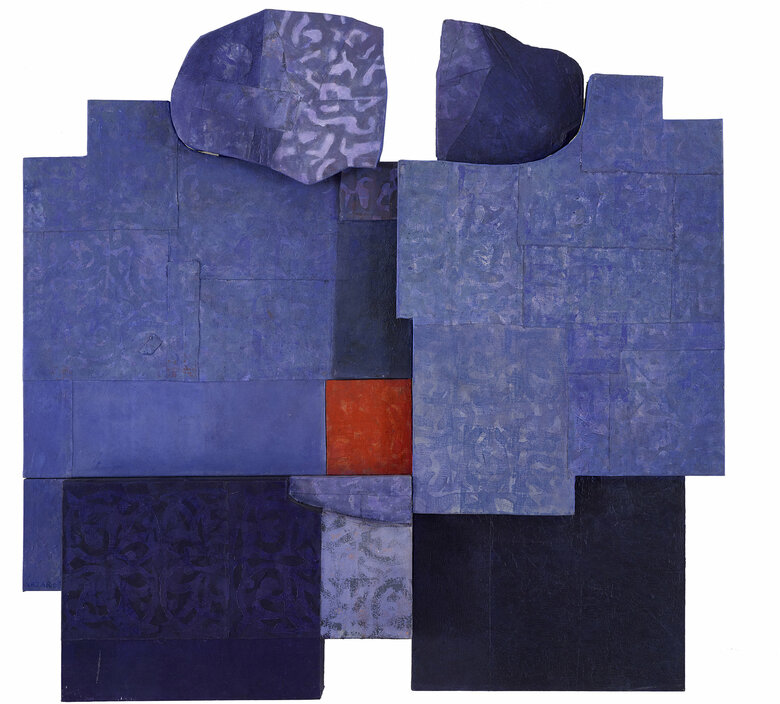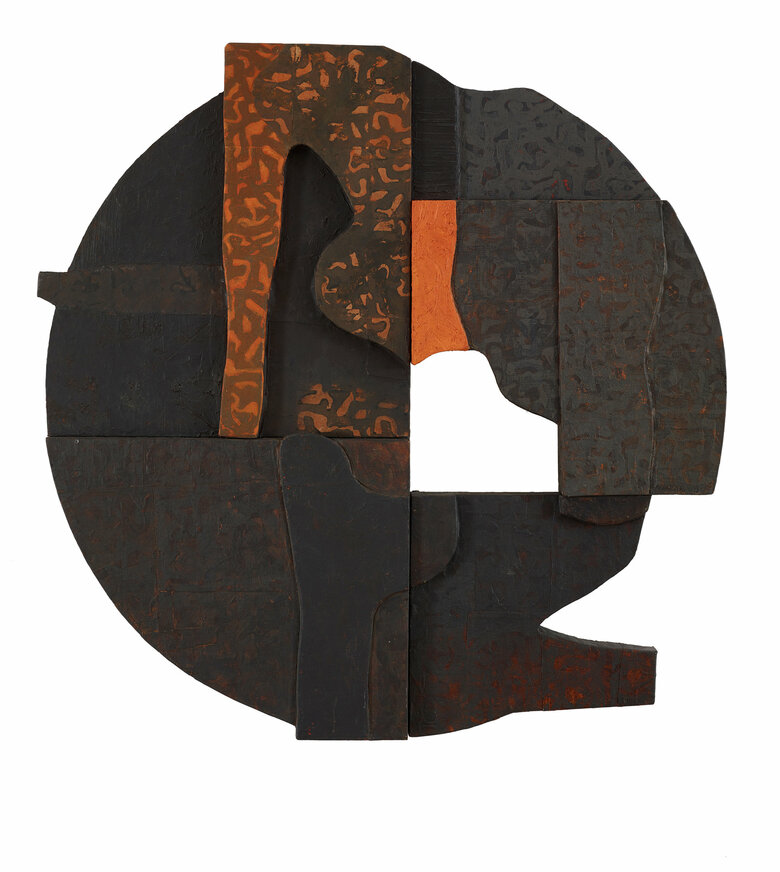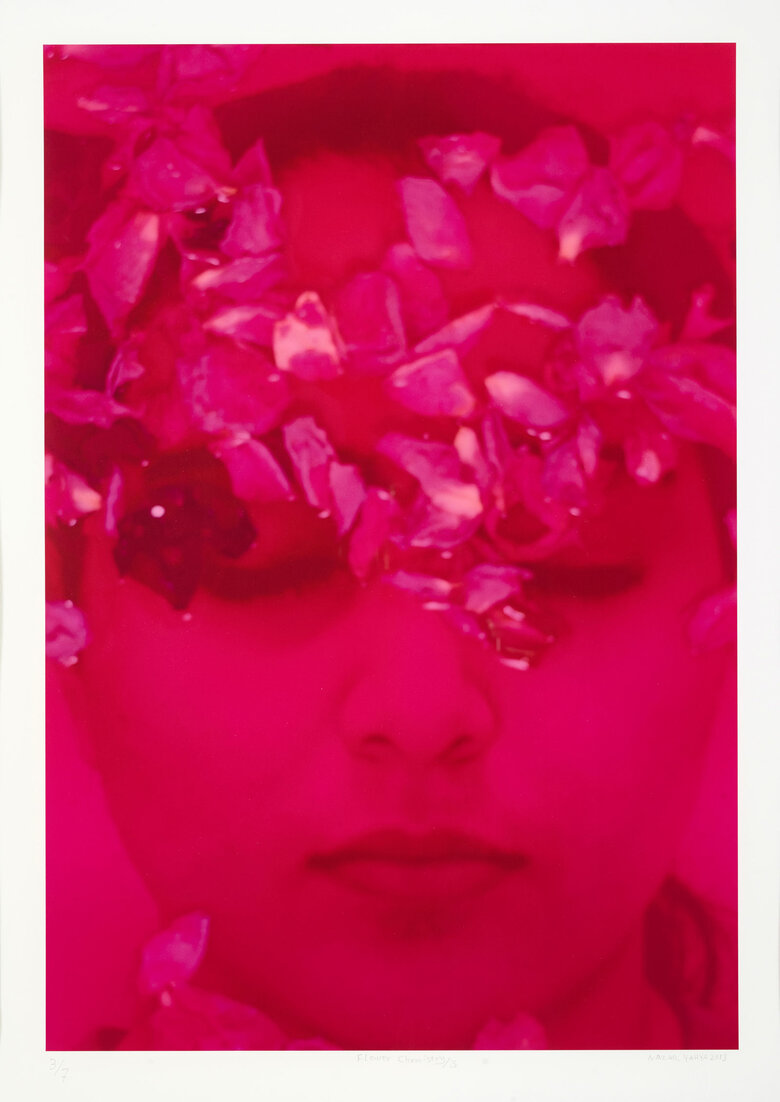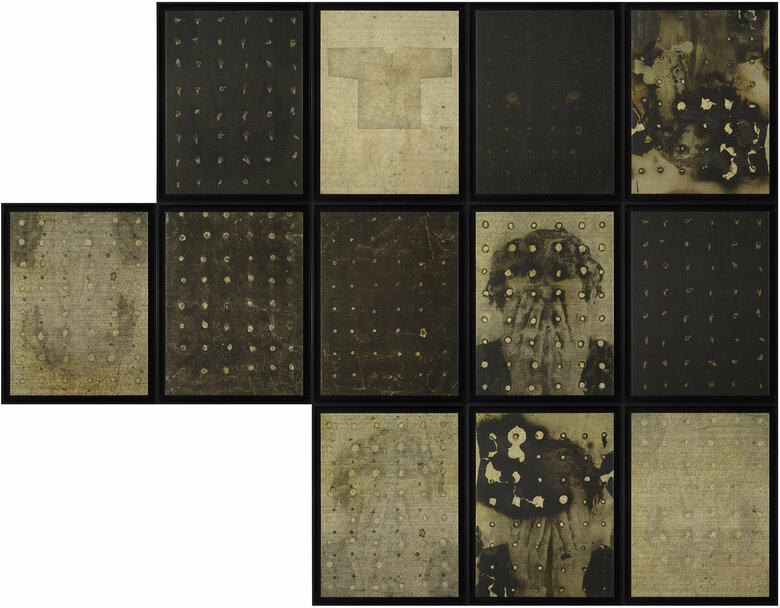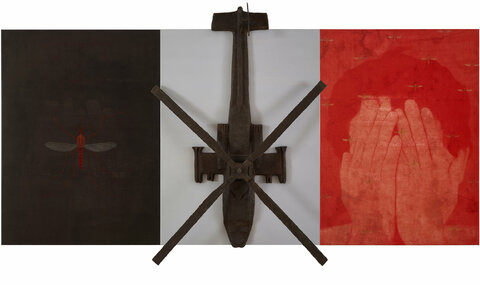Written by Liam Sibai Nazar Yahya was born in Baghdad, Iraq in 1963. Following in the footsteps of his father, a seasoned journalist and photographer, Yahya worked at a widely-read Iraqi...


NAZAR YAHYA, Iraq (1963)
Bio
Written by Liam Sibai
Nazar Yahya was born in Baghdad, Iraq in 1963. Following in the footsteps of his father, a seasoned journalist and photographer, Yahya worked at a widely-read Iraqi children’s magazine while still a high school student. In 1987, Yahya received his bachelor’s degree in painting from the Academy of Fine Arts in Baghdad. The artist’s youth was marked by almost constant contact with war. In just the first two decades of his life, Iraq saw the first Iraqi-Kurdish conflict, the Six-Day war, the October War, the second Iraqi-Kurdish conflict, and the first half of the Iran-Iraq War. Though in many ways Yahya’s work shares and builds upon themes and concerns taken up by many Iraqi artists before him, and is tied to events, ideologies, and iconography from Iraq and its wars, Yahya has a rather complicated relationship with the nation. He insists that he no longer has a country and is at peace with his feeling of statelessness.
Like everyone else in the Arab world, Yahya grew up in a culture rich in calligraphic traditions. In Iraq especially, the Hurufiyya movement inflected local practices of modern art. Hurufiyya is a movement or set of aesthetic principles that emerged in the mid-twentieth century, taking as its core concern the adaptation of Arabic calligraphy in abstract painting. Among its key proponents were pioneers of Iraqi modernism, such as Jewad Selim, Shakir Hassan Al Sa’id, and Jamil Hamoudi, who used the Arabic letter to explore the abstract’s relationship to the material through the lens of heritage and language. Yahya’s work tackles a similar discourse with an encompassing, detailed, and nuanced awareness of its political implications. He utilizes a larger ensemble of forms, media, references, and symbols than the visual lexicons utilized by his predecessors. In the 1990s, harsh international sanctions rendered Iraq culturally isolated, and the narratives of Iraqi art split according to geographical location. Because artists within Iraq could not easily communicate with their countrymen abroad, little exchange occurred during this period between Iraqi artists based in Iraq and Iraqi artists elsewhere. Though Nazar Yahya resided in Iraq until the very end of sanctions in 2003, he later practiced and exhibited internationally.
Yahya works in both painting and sculpture, and indeed has often incorporated both practices into individual works, as can be seen in Bad Game (2011). He incorporates both candid and staged photography in works like the Flower Chemistry series (2013) or I am Youssef (2013), and also works in acrylics on Chinese paper, such as in Spring(2010). The latter consists of two symbolic depictions of the Tigris that reflect the river’s alteration since the artist’s youth. The work draws inspiration from Islamic motif and geometry in its use of a rippling pattern. In it, one can see two recurring and interconnected techniques of Yahya’s; comparison and symbol. Comparing the present to the past is impossible without a document of the past. The production of such a document requires a system of signs and symbols, be it linguistic, numeral, or otherwise. While discussing Bad Game (2011), Yahya has compared helicopters to mosquitoes, both subjects of the piece, based on their nocturnal schedule of attack. Yahya often engages with ancient history, such as in the exhibition Yusuf (2011), where he uses the biblical story of Joseph to mirror the contemporary expulsion from one’s homeland that many Arabs face. Yahya has also cited Sufism and Sufi poetry as a quintessential part of his life, both as an inspiration for his work and as a source of philosophical guidance. An exhibition called The Truth (2014) broached the topic of Sufism through an exploration of oneness, a pillar of the faith.
Nazar Yahya fled Iraq in 2003, and since 2008 has lived in Houston, Texas with his family.
Sources
"Bio Nazar Yahya." Nazar Yahya. Accessed May 27, 2019. http://www.nazaryahya.com/data/biography.html.
"Nazar Yahya." Barjeel Art Foundation. Accessed May 27, 2019. https://www.barjeelartfoundation.org/artist/iraq/nazar-yahya/.
"NAZAR YAHYA." Station Museum of Contemporary Art. Accessed May 27, 2019. http://stationmuseum.com/?page_id=3056.
Organization. "INTERNATIONAL ART: Iraqi Contemporary Art: The Effects of War and Exile." HuffPost. December 07, 2017. Accessed May 29, 2019. https://www.huffpost.com/entry/iraqi-contemporary-art-in_n_795289.
Shabout, Nada. “Bifurcation of Iraq’s Visual Culture.” In We Are Iraqis: Aesthetics and Politics in a Time of War, 5-23
Pocock, Charles, Heba Elkayal, and Amar Dawod. Reconquista.
"Visual Vernacular: Artist Nazar Yayah." 1. https://www.freepresshouston.com/visual-vernacular-artist-nazar-yahya.
CV
Selected Solo Exhibitions
2019
Life's Army, Art Mejo, Amman, Jordan
Nazar Yahya-Private View, Karim Gallery, Amman, Jordan
2017
Of Things To Come, Mark Hachem Gallery, Beirut, Lebanon
2016
The Truth, Karim Gallery, Amman, Jordan
Nazar Yahya - Criterion, Albareh Art Gallery, Manama, Bahrain
2015
Nazar Yahya: Reconquista, Meem Gallery, Dubai, United Arab Emirates
2014
The Truth, Wade Wilson Art Gallery, Houston, USA
2012
Rosewater, Wade Wilson Art Gallery, Houston, USA
2011
Yusuf, Al Bareh Art Gallery, Bahrain
2008
Beard Code, Sultan Gallery, Kuwait
2007
Beard Land, Karmin Gallery, Amman, Jordan
2004
Blocks, Orfali Gallery, Amman
2002
Steel and Asphalt Memory, French Cultural Centre, Doha, Qatar
2001
French Cultural Centre, Doha, Qatar
2000
French Cultural Centre, Amman, Qatar
1994
Graphic Expiation, Riwaq Gallery, Baghdad, Iraq
Selected Group Exhibitions
2025
All Manner of Experiments: Legacies of the Baghdad Group for Modern Art, CCS Bard, Annandale-On-Hudson, New York, United States of America
2021
Converging Lines: Tracing the Artistic Lineage of the Arab Diaspora in the U.S., MEI Art Gallery, Middle East Institute, Washington D.C., District Of Columbia, USA
Cities Under Quarantine: The Mailbox Project, Villa Romana, Florence, Italy
2019
Objects of Imagination, Contemporary Arab Ceramics, National Gallery of Fine Arts, Amman, Jordan
2018
Millennia of Creativity, NABU, Betroun, Lebanon
Revolution generations, Mathaf, Arab Museum of Modern Art, Doha, Qatar
2017
BETWEEN TWO ROUNDS OF FIRE, THE EXILE OF THE SEA, Barjeel Art Foundation, Sharjah, United Arab Emirates
2015
Al Seef, Contemporary Art Platform, Kuwait
2012
Artifactul Realities, Station Museum, Houston, USA
Impressions, Wade Wilson Art Gallery, Houston, USA
2011
Art In Iraq Today: Conclusion, Meem Gallery, Dubai On the Edge of New, Wade Wilson Art Gallery, Houston, USA
2010
A Chair and Painting, Albareh Gallery, Bahrain My Home Land, Art Sawa Gallery, Dubai, UAE
Sajjil: A Century of Modern Art, Mathaf: Arab Museum of Modern Art, Doha, Qatar
Art in Iraq Today: Part II, Meem Gallery, Dubai, UAE
2008
Dafatir: Contemporary Iraqi Book Art, Denison University, Granville, Ohio, USA
Word into Art: Artists of the Modern Middle East, Dubai International Financial Centre (DIFC), Dubai, UAE
2007
Dafatir: Contemporary Iraqi Book Art,
The Centre for Book Arts, New York, USA
Dafatir: Contemporary Iraqi Book Art, Minneapolis Athenaeum, Minneapolis, Minnesota, USA
Dafatir: Contemporary Iraqi Book Art, NIU Art Museum, DeKalb, Illinois, USA
Dafatir: Contemporary Iraqi Book Art, The Jaffe Centre for Book Arts, Boca Raton, Florida, USA
Negative Positive to Iraqi Artists, Albareh Gallery, Manama, Bahrain
2006
Dafatir: Contemporary Iraqi Book Art, Carleton College, Northfield, Minnesota, USA
Dafatir: Contemporary Iraqi Book Art, University of Texas, El Paso, Texas, USA
Dafatir: Contemporary Iraqi Book Art, Daura Gallery, Lynchburg College, Lynchburg, Virginia, USA
World Into Art: Artists of the Modern Middle East, British Museum, London, UK
2005
Improvisation: Seven Iraqi Artists, Bissan Gallery, Doha, Qatar
Improvisation: Seven Iraqi Artists, Al-Riwaq Gallery, Bahrain
Improvisation: Seven Iraqi Artists, 4 Walls Gallery, Amman, Jordan
Dafatir: Contemporary Iraqi Book Art, University of North Texas, Houston, Texas, USA
Iraqi Artists, Musèe du Montparnasse, Paris, France
2003
Five Contemporary Artists from Iraq, Green Art Gallery, Dubai, UAE
2002
Asian Art Biennale, Dhaka, Bangladesh
2000
Fredrickstad Triennial, Fredrickstad, Norway
1999
Three Iraqi Artists, Agial Gallery, Beirut, Lebanon
Fifty Years of Iraqi Graphics, Darat Al Funun, Amman, Jordan
1997
Environment and Surroundings in Iraqi Art, Jordan National Gallery of Fine Arts, Amman, Jordan
Homage to Jawad Selim, Athar Gallery, Baghdad, Iraq
1985
Fredrickstad Biennale, Fredrickstad, Norway
Awards
2004
First Prize for Painting, Emaar, Dubai, UAE
Collections
British Museum, London, UK
Museum of Modern Art, Baghdad, Iraq
Mathaf: Arab Museum of Modern Art, Doha, Qatar
Jordan National Gallery of Fine Arts, Amman, Jordan
The Hussain Ali Harba Family Collection, Italy
Kinda Foundation, Riyadh, Saud Arabia
Station Museum of Contemporary Art, Houston, USA
Barjeel Art Foundation, Sharjah, UAE
Documents
Art in Iraq Today
Dia Al-Azzawi, Charles Pocock, Jabra L. Jabra, May Muzaffar, Nada M. Shabout, Samar Farouqi, and Geo
Skira, English, 2011
Excerpt from book p. 266-279
Nazar Yahya, Longing for Eternity
Salam Atta Sabri, Mary Angela Schroth, Silvia Naef, Mary Angela Schroth, and Assim Abdul Amir
Skira, English, 2013
Excerpt from book p. 281-283
Press
يعرض اعماله في غاليري الورفلي : التشكيلي نزار يحيى يذهب نحو الأعماق البصرية في تجربته الجديدة
addustour.com, Arabic, 2004
Iraqi contemporary art influenced by experiences of war and exile
mutualart.com, English, 2010
Wade Wilson Art opening reception: Nazar Yahya: The Truth
houston.culturemap.com, English, 2014
لوحات الفنان العراقي «نزار يحيى» في أستوديو رؤية للفنون بجدة
anbaanews.com, Arabic, 2014
Karim Gallery: Pop-up Exhibition by Nazar Yahya
Artmejo, English, 2019
NAZAR YAHYA Artwork
Become a Member
Join us in our endless discovery of modern and contemporary Arab art
Become a Member
Get updates from DAF
Follow Artists
Save your favourite Artworks
Share your perspectives on Artworks
Be part of our community
It's Free!
We value your privacy
TermsCookiesPrivacy Policies
Become a Member
Get updates from DAF
Follow Artists
Save your favourite Artworks
Share your perspectives on Artworks
Be part of our community
It's Free!
We value your privacy
TermsCookiesPrivacy Policies
Become a Member
Get updates from DAF
Follow Artists
Save your favourite Artworks
Share your perspectives on Artworks
Be part of our community
It's Free!
We value your privacy
TermsCookiesPrivacy Policies
Welcome to the Dalloul Art Foundation
Thank you for joining our community
If you have entered your email to become a member of the Dalloul Art Foundation, please click the button below to confirm your email and agree to our Terms, Cookie & Privacy policies.
We value your privacy, see how
Become a Member
Get updates from DAF
Follow Artists
Save your favourite Artworks
Share your perspectives on Artworks
Be part of our community
It's Free!
We value your privacy
TermsCookiesPrivacy Policies

